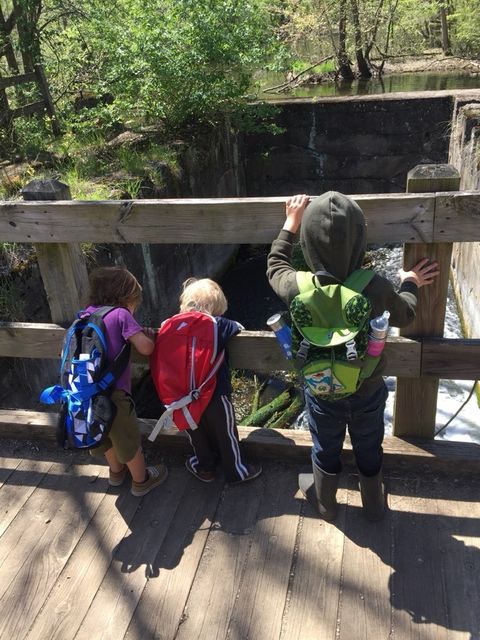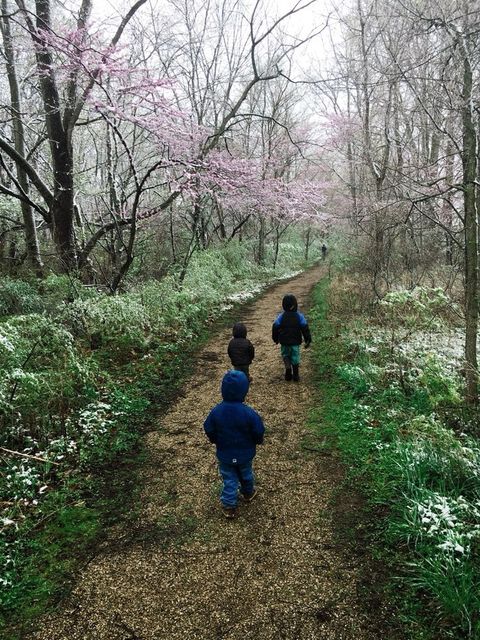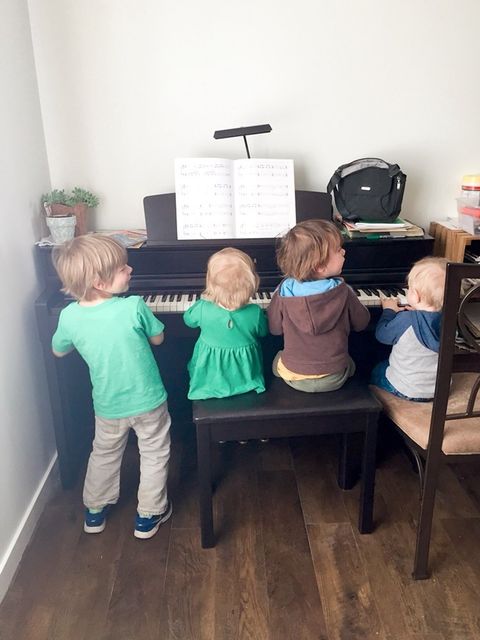(Names have been changed to protect the privacy of the individuals)
In December, just before the year 2020 came crashing down on the world, the Keane family – Leah, her husband James, and their two young sons – were trimming their Christmas tree in their family home in Indiana. They’d picked it up at the tree farm, a budding tradition for a family in love with the outdoors. While piling on lights, Naomi saw she had a missed call from her friend (who we will call Lindsay, to protect her privacy).
“She left a rather frantic voicemail saying The Department of Child Services (DCS, Indiana’s Department of Child Protection and Permanency) was going to take her three-week-old,” Leah said.
Her heart sunk.
Two years ago, a pregnant Leah was in the hospital, her heart struggling to beat due to pregnancy induced heart failure. At one point, her heart actually stopped. But with a team of doctors by her side, she gave birth to her son, albeit three months early. It was under these traumatic circumstances that Leah met Lindsay.
She remembered her oldest son opening up to Lindsay’s six children, a smile emerging beneath his straight blonde hair. “He was about two, just starting to socialize, so their family was important to him.”
Lindsay’s youngest son was born six days before Leah’s, they were both almost three months early.
“We stayed in the same hospitality house while our newborns recovered,” Leah said. It was there that Leah’s son met Lindsay’s seven children and began to understand how to interact with other kids.
Premature babies are underdeveloped and vulnerable, and Leah was eager to spend time with her baby boy. It can be stressful for an infant to be exposed to an isolating incubator, despite the technological advancements in the equipment used to keep them alive, like sound reduction and light filtration. It’s still a foreign experience to the comfort of the womb or laying skin to skin on the chest of their mother and coming home to the sounds and smells of the place where they will, ideally, be loved and kept safe for years to come.
Studies have shown that premature babies have a lower rate of something called vagal tone, which is type of heart rate measurement that is predictive of a newborn’s (and anyone’s) ability to adapt to stressful situations. Vagal tone is also intertwined with nervous system functioning.
“Once we went to drop off food to them and my oldest boy saw where they were living, and he asked ‘Mommy, if we give up our Christmas presents this year can we buy them a new house?’”
The autonomic nervous system (ANS) is made up of the sympathetic and parasympathetic nervous systems. Roughly speaking, the sympathetic nervous system (SNS) can be thought of as a red light (or fight-or-flight) signaling that a person is not safe, and must work to achieve safety. It controls the automatic stress responses, like pupil dilation and increased heart rate, which allow people to effectively respond to stressful situations. The parasympathetic nervous system (PNS), on the other hand, is like a green light (or rest and digest), signifying safety and the go-ahead for business as usual. Sometimes, however, the SNS can become over activated, like in people with trauma and high Adverse Childhood Experience (ACES) scores, causing the body to be in a chronic state of fight-or flight which can cause certain difficulties and health problems.
Nervous system function is also essential for newborns to become attuned to their caregivers and to form a secure attachment. For this reason, it is important for [Neonatal Intensive Care Unit] NICU babies to be loved and cared for so that their nervous systems develop properly.
Lindsay had more difficulty spending quality time with her premature son in the NICU. She didn’t have much time off work, and her husband was struggling with job security. She was forced to prioritize keeping her six other children afloat. “As unfortunate as it was, she knew that at the NICU her baby was being cared for by the nurses,” Leah said.
So, with other demands at home, Lindsay and her husband didn’t see their premature baby as much as Leah knew was beneficial.
Leah was told her baby boy would be in the NICU for over two months, but this was her second preemie, and Leah knew that spending quality time with her boy could decrease his time in the hospital. With attention and intentional visits, he left in six weeks. Lindsay’s boy, however, fell behind, spending longer in the NICU than Leah’s son before being taken home.
Two years later, DCS had determined that Lindsay’s home was unsafe for her three-week-old baby, who we will call Erin. Leah had some inklings about neglect and drug use. And even her wide-eyed three-year-old son could see that the family wasn’t living in healthy conditions.
“Once we went to drop off food to them and my oldest boy saw where they were living, and he asked ‘Mommy, if we give up our Christmas presents this year can we buy them a new house?”

Leah called Lindsay back as her family continued trimming the tree.
On the other end, a Department of Child Services worker asked if the Keanes would be willing to provide temporary care to Erin. “I looked over at my husband and was like, ‘Can we take this baby?’ He was like, ‘Yeah,’ We always go back to, how could we have said no?”
An hour later, Leah and James entered the hospital where the infant’s physical health was under evaluation. They waited four hours to be taken to triage, where they found themselves among a flurry of nurses tossing the wrong-size diapers, baby formula, and other newborn essentials into a bag after finding out they were a kinship foster family, meaning they knew the children before taking them into their home.
“They clearly cared about this baby” Leah said.
Leah and James brought baby Erin home to the twinkling lights and fresh pine smell of the newly trimmed Christmas tree. They placed her crib next to the tree, and the Keane boys were in awe at the tiny baby under the soft lights, just before Christmas.
Human infants are born in need. According to Dr. Bessel van der Kolk in his essential trauma-informed book, The Body Keeps the Score: “We are profoundly social creatures; our lives consist of finding our place within the community of human beings.” Further, he writes, “Children become attached to whoever functions as their primary caregiver.”
In all foster and kinship care situations, the role of primary caregiver is blurred. Perhaps this confusion plays a role in a child’s ability to bond. Leah was doing her best to provide a secure attachment for Erin, despite the difficulty of knowing that she was caring for and bonding to an infant who was being missed by others. This may have been even more challenging because Leah and James valued the friendship of these other caregivers.
Soon, the situation became even more complex.
“Three weeks later we got the second call from DCS saying they were removing the rest of the kids,” Leah said.
Leah and James made the choice to take the second youngest, the toddler who, two years earlier, had been born six days before the couple’s younger son. We will call him Graham.
Leah was already mother to two premature babies, and she was well-aware that they had a higher risk of issues like developmental delays.
“I also knew there could be delays related to drug use,” she said of the children she was bringing into her home. DCS workers asked if she was sure she wanted to take this on. After all, she had never fostered, and knew nothing about foster care. “I wanted to do this because I knew he would have delays that I could help with,” Leah said.
When Graham arrived, pandemic quarantine soon provided the perfect circumstances for cocooning, an attachment parenting technique. “You sort of circle the wagons, no one comes over and you don’t go anywhere. It’s all about creating a safe space for the child. Allowing them to tell you who they are and what they need.”
Leah and James had practiced attachment parenting with their own biological kids by incorporating co-sleeping, child-wearing, and responding to all their children’s cries.
Leah told me that Graham has had more emotional instability than Erin. He also has developmental disabilities. And she explained some methods they’ve used to manage his moods. When Graham gets overwhelmed, he will throw himself on the floor and sob. On days like that, Leah would wear two-year-old Graham around the house for entire afternoons. “He just needed a safe place to be sometimes,” she said.
Being close to Leah for extended periods of time could allow Graham’s trauma-shaped nervous system to become attuned to hers. It helped him calm down.
“Of course, there are times when you get touched-out,” Leah says.
“We were really thinking that we might need to ask for a placement change”
Leah cites nature, and hiking in particular, as one of she and James’s most healing activities. They take off down a sun-dappled trailhead, and eventually Leah or James will let the other take the dog and split off for some alone time. “Sometimes he’s resistant” said Naomi, “but I am like, please, go. His love language is acts of service, so it’s one gift I can give him to show my love.”
Still, there have been plenty of times that things have felt overwhelming. James is the manager in a grocery store, and as everyone knows, during the summer of 2020, at the height of the toilet-paper hoarding pandemic panic, grocery stores were unmanageable places.
“It was just hot, and he was having a tough week at work, and Graham had just gone back to in-person visits, so his moods were all over the place,” Leah said.
James was overheated, exhausted, and hardly able to be present for a child who had tendency to throw himself down on the floor and scream. “He said, I just don’t know if I can do this anymore.”
“We were really thinking that we might need to ask for a placement change,” Leah said.
Then, a friend recommended aromatherapy.
The olfactory system and nervous systems are linked, and it would make sense that when a child becomes dysregulated, mindful inclusion of a pleasant scent could help bring them into their body, help them to breathe and calm down.
Of course, essential oil therapy is not approved by the FDA, so any positive effects haven’t been studied for evidenced-based causation. But, for the Keanes, something shifted. “When he would get upset, we explained that we were going to try a relaxation method, then we put certain oil blends on his neck and wrists and told him he could smell them to calm down.”
It came to the point where when he got upset, Graham would come ask Leah and James for the oils himself.
Leah thinks that their nurturing parenting style has been helpful for Graham’s moods. They went from that sweltering summer day, thinking them might need a placement change, to Graham wanting to calm himself down when he got upset.

The Keanes were uncertain what was going to happen with these kids. Last spring, their sights were set on reunification. Their biological parents seemed to be on track, and Leah was hoping to send Graham and Erin home.
But come February, they weren’t putting in the effort anymore. Leah and James were anticipating a drawn-out court-case. But when James showed up to the first hearing, Lindsey and her husband explained that they wanted to sign over their adoption rights.
“They didn’t look like they had been taking care of themselves,” Leah said.
Leah and James had the task of explaining the complexities of foster care and adoption to their two sons who were two and almost five.
When Leah explained the situation, that Erin and Graham’s parents needed to heal, her oldest boy asked, “Why didn’t we just take the whole family and help them heal?”
“He always tends to boil things down to their most basic components,” Leah said, laughing, “and he really makes me think”
It’s a great question.
With foster care, one hope is that removing children will give the parents time to work on healing and getting help. But as we see too often, this doesn’t always work. Leah wasn’t in court that day, but her husband said the parents looked relieved upon signing away their parental rights.
Leah can’t imagine being in their situation.
In his book, Van der Kolk discusses how trauma is often the cause of addiction and other dysfunction, like the kind of behavior seen in addiction and neglect removals. He cites studies that indicate that childhood trauma impacts the regulation of the nervous system, as mentioned before.
How many parents are out there struggling with nervous system dysregulation while trying to also raise a family? Without trauma-informed support, these difficulties are incredibly challenging to work through.
Leah holds Erin and Graham’s parents in her heart as she tries her best to do right by their children. She has a group text with the foster parents of their siblings – they have mandated weekly sibling visits and they spend birthdays together.
Graham looks up to his older brothers, despite being the little guy who sometimes gets left behind.
Miraculously, Christmas arrived again this year, although for many it may have looked and felt different. At the Karth’s, the tree in the living room signified a full year since Erin arrived as an infant in their home.
Her brothers are as enamored as ever with her, though she’s not the tiny baby in the soft glow of the tree anymore. This year she watched as her brothers played with what Leah called a “sensory Christmas tree” because the kids, especially Graham -whose first official Christmas Leah suspects it was — couldn’t stop touching it.
Leah and James strung the lights and gave the kids soft, plush toys that they can add and remove from the tree at their childlike whims.
These types of compromises make her life manageable.
“It’s not the way I would do a tree,” she said, “but as I told my husband, I have to lower my expectations. If they love the tree that much, they should get to enjoy it.”



It’s a great & sad story—much room for tears. Touches some tender points for me.
You may want to do a bit more editing though, because 2 or 3 times you have allowed “Naomi” in the script.
Thanks for that! It was a tricky last minute change to not include their real names. We appreciate your feedback.